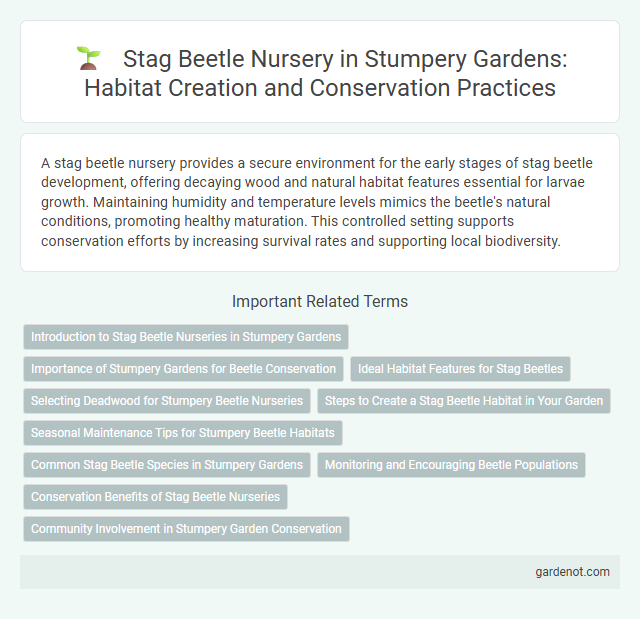A stag beetle nursery provides a secure environment for the early stages of stag beetle development, offering decaying wood and natural habitat features essential for larvae growth. Maintaining humidity and temperature levels mimics the beetle's natural conditions, promoting healthy maturation. This controlled setting supports conservation efforts by increasing survival rates and supporting local biodiversity.
Introduction to Stag Beetle Nurseries in Stumpery Gardens
Stag beetle nurseries in stumpery gardens provide essential habitats for the larvae of Lucanus cervus, supporting their development in decaying wood environments. These nurseries mimic natural woodland conditions by incorporating rotting logs and moist soil, promoting biodiversity and aiding conservation efforts. Creating such habitats encourages stag beetle population growth while enhancing the ecological value of stumpery gardens.
Importance of Stumpery Gardens for Beetle Conservation
Stumpery gardens provide critical habitat for stag beetle larvae by offering decaying wood essential for their development. These gardens support biodiversity by creating microhabitats that protect beetles from predators and environmental stress. Conserving and establishing stumperies directly contributes to the preservation of stag beetle populations, which are indicators of healthy woodland ecosystems.
Ideal Habitat Features for Stag Beetles
Stag beetle nurseries thrive in environments with abundant decaying hardwood, such as oak or beech, which provide essential larvae food sources and shelter. Moist, well-aerated soil rich in organic matter supports the development of larvae through its decomposed wood material and stable microclimate. Dead wood piles, tree stumps, and shaded, undisturbed garden corners create ideal habitats that protect stag beetle larvae from predators and extreme weather conditions.
Selecting Deadwood for Stumpery Beetle Nurseries
Selecting deadwood for a stag beetle nursery in a stumpery involves choosing rotting hardwood logs such as oak, beech, or ash that provide ideal conditions for larval development. The wood should be moist but not waterlogged, with varying sizes and stages of decay to support different life cycle stages of the beetle. Placing deadwood in shaded, sheltered areas of the stumpery enhances habitat suitability and encourages successful stag beetle breeding and conservation.
Steps to Create a Stag Beetle Habitat in Your Garden
Create a stag beetle habitat by first selecting a shaded, moist area in your garden with plenty of decaying wood, as stag beetles rely on rotting logs for larval development. Incorporate logs, stumps, and leaf litter to mimic natural woodland floors, ensuring the wood is untreated and buried partially to maintain suitable humidity levels. Maintain the habitat by avoiding chemical pesticides and periodically adding fresh decaying wood to support the beetle life cycle and promote biodiversity.
Seasonal Maintenance Tips for Stumpery Beetle Habitats
Stag beetle nurseries require seasonal maintenance to ensure healthy habitats within a stumpery, focusing on preserving decaying wood and managing soil moisture during spring and autumn. Removing invasive plants and gently turning leaf litter encourages aeration critical for larval development in summer months. Winter preparation involves insulating beetle habitats with natural mulch to protect larvae from frost while maintaining a damp environment to support biodiversity.
Common Stag Beetle Species in Stumpery Gardens
Common stag beetle species in Stumpery gardens include Lucanus cervus, characterized by their large mandibles and metallic brown bodies, which thrive in decaying wood habitats. These beetles play a crucial role in the ecosystem by aiding in the decomposition of dead wood, enriching soil health. Creating a stag beetle nursery by maintaining moist, rotting logs and leaf litter maximizes breeding success and supports population sustainability.
Monitoring and Encouraging Beetle Populations
Stag beetle nurseries play a crucial role in monitoring and encouraging beetle populations by providing ideal habitats with decaying wood and leaf litter essential for larval development. Regular surveys and habitat assessments track population health and identify environmental threats, enabling targeted conservation efforts. Supplementing these habitats with controlled microclimates and predator protection increases breeding success and supports long-term stag beetle population growth.
Conservation Benefits of Stag Beetle Nurseries
Stag beetle nurseries provide critical habitats that support the breeding and development of Lucanus cervus larvae by offering decaying wood essential for their growth. These nurseries enhance local biodiversity by preserving stag beetle populations, which play a vital role in nutrient cycling and soil health. Conserving these habitats helps counteract the decline caused by urbanization and deforestation, ensuring the survival of this ecologically important species.
Community Involvement in Stumpery Garden Conservation
Community involvement plays a crucial role in the conservation of stag beetle nurseries within stumpery gardens, where decaying wood habitats are preserved to support their lifecycle. Local volunteers and conservation groups collaborate in maintaining fallen logs and deadwood piles, essential for larval development of Lucanus cervus. Educational programs raise awareness about the stag beetle's ecological significance, fostering public support for habitat restoration and biodiversity protection initiatives.
Stag beetle nursery Infographic

 gardenot.com
gardenot.com